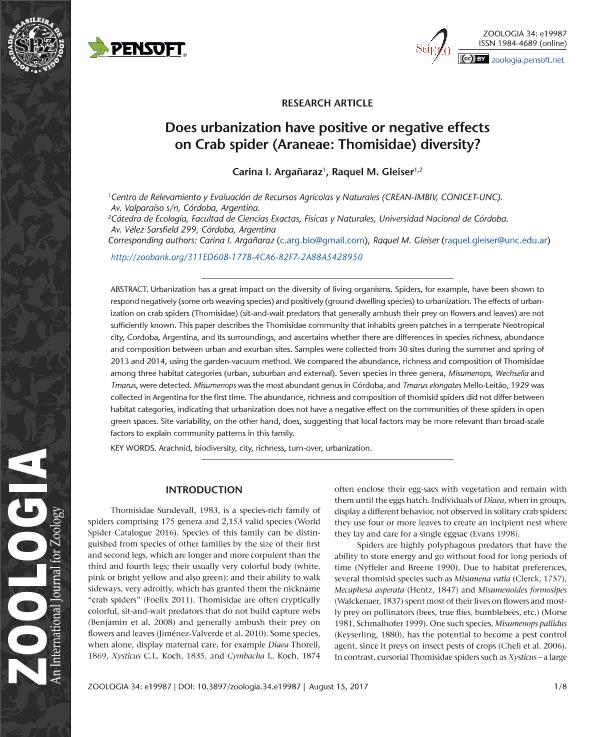Mostrar el registro sencillo del ítem
dc.contributor.author
Argañaraz, Carina Inés

dc.contributor.author
Gleiser, Raquel Miranda
dc.date.available
2019-04-22T18:05:55Z
dc.date.issued
2017-01
dc.identifier.citation
Argañaraz, Carina Inés; Gleiser, Raquel Miranda; Does urbanization have positive or negative effects on Crab spider (Araneae: Thomisidae) diversity?; Sociedade Brasileira de Zoologia; Zoologia (Curitiba); 34; 1-2017
dc.identifier.issn
1984-4670
dc.identifier.uri
http://hdl.handle.net/11336/74673
dc.description.abstract
Urbanization has a great impact on the diversity of living organisms. Spiders, for example, have been shown to respond negatively (some orb weaving species) and positively (ground dwelling species) to urbanization. The effects of urbanization on crab spiders (Thomisidae) (sit-and-wait predators that generally ambush their prey on flowers and leaves) are not sufficiently known. This paper describes the Thomisidae community that inhabits green patches in a temperate Neotropical city, Cordoba, Argentina, and its surroundings, and ascertains whether there are differences in species richness, abundance and composition between urban and exurban sites. Samples were collected from 30 sites during the summer and spring of 2013 and 2014, using the garden-vacuum method. We compared the abundance, richness and composition of Thomisidae among three habitat categories (urban, suburban and external). Seven species in three genera, Misumenops, Wechselia and Tmarus, were detected. Misumenops was the most abundant genus in Córdoba, and Tmarus elongates Mello-Leitão, 1929 was collected in Argentina for the first time. The abundance, richness and composition of thomisid spiders did not differ between habitat categories, indicating that urbanization does not have a negative effect on the communities of these spiders in open green spaces. Site variability, on the other hand, does, suggesting that local factors may be more relevant than broad-scale factors to explain community patterns in this family.
dc.format
application/pdf
dc.language.iso
eng
dc.publisher
Sociedade Brasileira de Zoologia

dc.rights
info:eu-repo/semantics/openAccess
dc.rights.uri
https://creativecommons.org/licenses/by-nc-sa/2.5/ar/
dc.subject
Arachnid
dc.subject
Biodiversity
dc.subject
City
dc.subject
Richness
dc.subject
Turn-Over
dc.subject
Urbanization
dc.subject.classification
Otras Ciencias Biológicas

dc.subject.classification
Ciencias Biológicas

dc.subject.classification
CIENCIAS NATURALES Y EXACTAS

dc.title
Does urbanization have positive or negative effects on Crab spider (Araneae: Thomisidae) diversity?
dc.type
info:eu-repo/semantics/article
dc.type
info:ar-repo/semantics/artículo
dc.type
info:eu-repo/semantics/publishedVersion
dc.date.updated
2019-04-15T18:25:07Z
dc.identifier.eissn
1984-4689
dc.journal.volume
34
dc.journal.pais
Brasil

dc.description.fil
Fil: Argañaraz, Carina Inés. Consejo Nacional de Investigaciones Científicas y Técnicas. Centro Científico Tecnológico Córdoba. Instituto Multidisciplinar de Biología Vegetal (P). Grupo Vinculado Centro de Relevamiento y Evaluación de Recursos Agrícolas y Naturales; Argentina
dc.description.fil
Fil: Gleiser, Raquel Miranda. Consejo Nacional de Investigaciones Científicas y Técnicas. Centro Científico Tecnológico Córdoba. Instituto Multidisciplinar de Biología Vegetal (P). Grupo Vinculado Centro de Relevamiento y Evaluación de Recursos Agrícolas y Naturales; Argentina
dc.journal.title
Zoologia (Curitiba)

dc.relation.alternativeid
info:eu-repo/semantics/altIdentifier/doi/http://dx.doi.org/10.3897/zoologia.34.e19987
Archivos asociados
